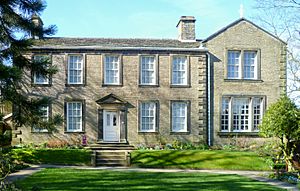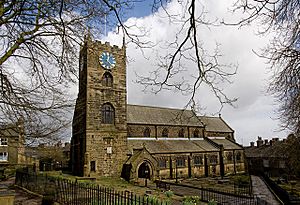Brontë Parsonage Museum facts for kids
The Brontë Parsonage Museum is a special house museum. It celebrates the famous Brontë sisters: Charlotte, Emily, and Anne. This museum is in their old family home, called the parsonage, in Haworth, England. The sisters lived here most of their lives and wrote their well-known novels.
The Brontë Society helps keep the museum and its collections safe. It is one of the oldest groups dedicated to literature in the English-speaking world. The parsonage building is very important, listed as Grade I on the National Heritage List for England.
The Brontë Family Home
The parsonage was built a long time ago, between 1778 and 1779. In 1820, Patrick Brontë, the sisters' father, moved into the parsonage. He came with his wife, Maria, and their six children. This house became their family home for the rest of their lives. The wild moorland around the house greatly inspired Charlotte, Emily, and Anne's writing. Their father was also a writer, so the children grew up seeing books with their family name on the shelves.
In 1821, Maria Brontë, the mother, passed away. Her sister, Elizabeth Branwell, came to live with them and help run the house. In 1824, the four oldest sisters went to a school called Clergy Daughters' School. Sadly, the oldest daughter, Maria, became ill and died at the parsonage in May 1825, when she was eleven. Her sister Elizabeth also died shortly after, in June, at age ten.
Becoming Famous Writers
In 1846, Charlotte, Emily, and Anne used some money from their aunt to publish their poems. They used pen names to hide their real identities: Currer, Ellis, and Acton Bell. Their book of Poems was published, but only two copies were sold.
Charlotte's first novel, The Professor, was not accepted by publishers at first. However, one publisher, Smith, Elder & Co., encouraged her to send them her next book. This book was Jane Eyre, and it was published on October 19, 1847. Emily's novel, Wuthering Heights, and Anne's novel, Agnes Grey, were also published in December 1847.
Later, after Anne's second novel, The Tenant of Wildfell Hall, Charlotte and Anne had to tell everyone their real names. Their brother, Branwell, became very ill and died on September 24, 1848, at 31. Emily also became ill and passed away on December 19, 1848, at 30. Anne also suffered from an illness. She went to Scarborough for a sea cure but died there on May 28, 1849, at 29 years old.
Charlotte finished her novel Shirley, which was published in October 1849. Her last novel, Villette, came out in 1853. She married Arthur Bell Nicholls, her father's assistant, on June 29, 1854. Charlotte died on March 31, 1855, at 38 years old. Patrick Brontë, the father, lived at the parsonage for six more years. He was cared for by his son-in-law and died there on June 7, 1861, at 84.
The Brontë Society and Museum
After Patrick Brontë died in 1861, the items in the parsonage were sold. Friends and servants also sold keepsakes and letters. In 1893, a librarian from Bradford suggested that items, letters, and documents about the Brontës should be collected and saved. The Brontë Society was then created. They started collecting Brontë items.
By 1895, the collection was big enough to be shown in a museum in Haworth. The society quickly gained many members, and about 10,000 people visited the museum in its first year. In 1928, Sir James Roberts bought Haworth Parsonage for £3,000. He turned it into a museum and gave it to the Brontë Society.
Henry Bonnell also gave his large collection to the society in 1926. This collection was moved to the parsonage when it opened, making it available for people studying the Brontës. The museum's collection has continued to grow over the years. The society now has about 2,000 members.
In 2011, a special item was given to the museum: the mahogany desk where Charlotte wrote her novels. This desk had been privately owned for over a century. A person bought it for £20,000 in 2009 and then donated it to the museum.
See also
- Grade I listed buildings in City of Bradford
- Listed buildings in Haworth, Cross Roads and Stanbury



